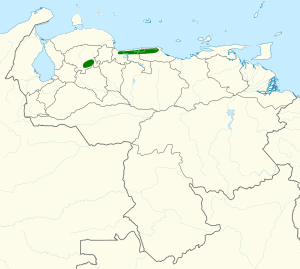Blood-eared parakeet facts for kids
Quick facts for kids Blood-eared parakeet |
|
|---|---|
| Conservation status | |
| Scientific classification | |
 |
The blood-eared parakeet (Pyrrhura hoematotis) is a colorful bird that lives only in Venezuela. It's also called the red-eared parakeet or red-eared conure by people who keep birds. This parakeet belongs to the parrot family, which includes many types of parrots from Africa and the Americas. It is a unique bird found only in its native country.
Contents
What is a Blood-Eared Parakeet?
The blood-eared parakeet is a type of parrot. It is known for its bright colors. These birds are about 25 cm (10 in) long. They weigh between 64 and 74 grams (2.3 to 2.6 oz). Both male and female parakeets look the same.
How to Identify a Blood-Eared Parakeet
This parakeet has a special look. Its forehead and the top of its head are a dark gray color. It has white skin around its eyes. The most striking feature is its bright terracotta, or reddish-orange, ear patches. These patches give the bird its name.
The back of its neck has green feathers with yellow edges. The rest of its upper body is green. Its throat and upper chest are yellowish-green. These feathers have grayish edges, making them look a bit scaly. The rest of its belly is green, with some reddish-brown spots. Its wings are mostly green, with blue feathers at the tips. The top of its tail is reddish-brown with green tips. The underside of its tail is a coppery color.
Different Types of Blood-Eared Parakeets
There are two main types, or subspecies, of the blood-eared parakeet. The first is called P. h. hoematotis. The second is P. h. immarginata. The immarginata subspecies has a green crown and neck. It also has fewer scales on the sides of its neck.
Where Do Blood-Eared Parakeets Live?
The blood-eared parakeet lives only in Venezuela. Each subspecies lives in a different part of the country.
Blood-Eared Parakeet Habitat
The P. h. hoematotis subspecies lives in the Venezuelan Coastal Range. This area is between the states of Aragua and Miranda. The P. h. immarginata subspecies is found in the Andes mountains. Specifically, it lives in southeastern Lara state.
These parakeets like to live in certain types of forests. They prefer the inside and edges of cloudforests. They also live in secondary forests, which are forests that have regrown after being cut down. You can also find them in wooded savannas. These are open grasslands with scattered trees. They usually live at high elevations. This is typically between 1000 and 2000 meters (3,300 to 6,600 ft) above sea level.
Blood-Eared Parakeet Behavior
These parakeets have interesting daily habits.
Seasonal Movements
During the dry season, some blood-eared parakeets move. They fly to lower areas. Here, they find semi-deciduous forests. These are forests where some trees lose their leaves in the dry season.
What Do Blood-Eared Parakeets Eat?
Blood-eared parakeets usually look for food in small groups. They search in the tops of trees, called the forest canopy. Their diet includes many things. They eat fruits, seeds, and flowers. They might also eat insect larvae, which are young insects.
How Do Blood-Eared Parakeets Raise Their Young?
Not much is known about how these parakeets raise their families. They are known to build nests during the wet season. This usually happens around August. More research is needed to learn about their breeding habits.
Blood-Eared Parakeet Sounds
The blood-eared parakeet makes several different sounds. Its most common call is a series of harsh notes. It sounds like "krree krree krree." They make this sound when they are sitting on a branch or flying.
When perched, they might also make single notes. These sound like "kurree," "kurruk," or "krreekuk." However, perched birds are often quiet. When a group of parakeets flies together, they call often. They make a loud, harsh chattering sound.
Conservation Status of the Blood-Eared Parakeet
The IUCN (International Union for Conservation of Nature) checks on animal populations. They have listed the blood-eared parakeet as "Least Concern." This means it is not currently in danger of disappearing.
However, its home range is small. The total number of these birds is not known. Experts believe their population might be shrinking. No immediate threats have been found. The parakeet lives in several protected areas. Still, because its range is small and its numbers might be going down, it is important to keep an eye on this species. We need to find out how many blood-eared parakeets there are.
See also
 In Spanish: Perico de cuello rojo para niños
In Spanish: Perico de cuello rojo para niños


